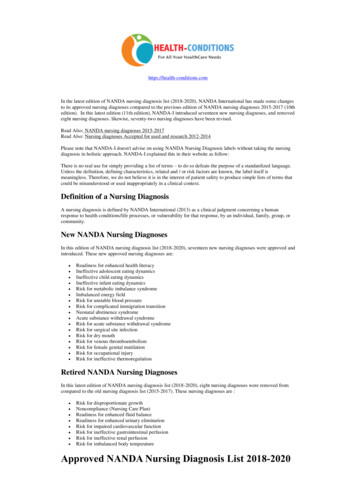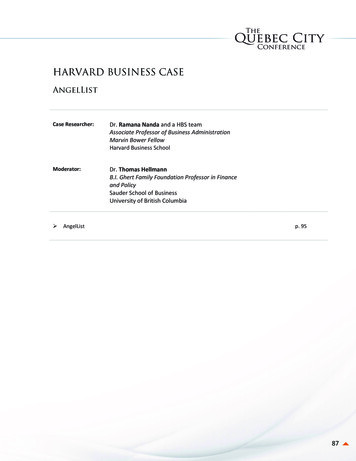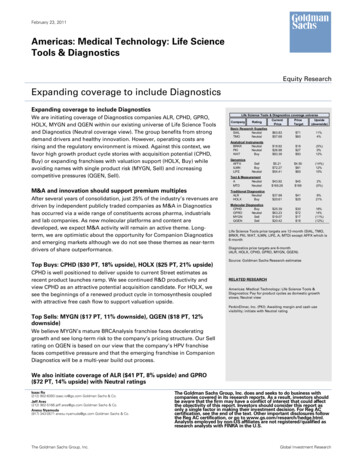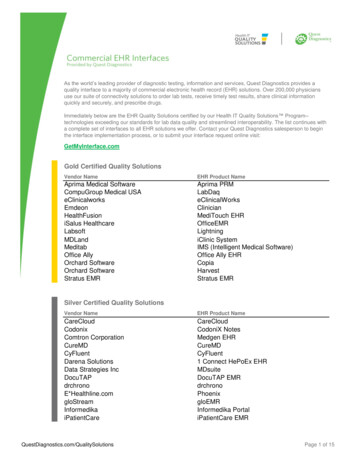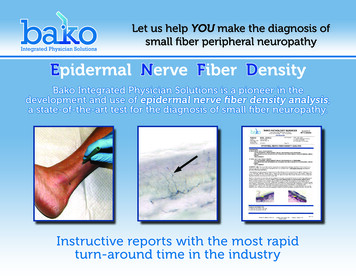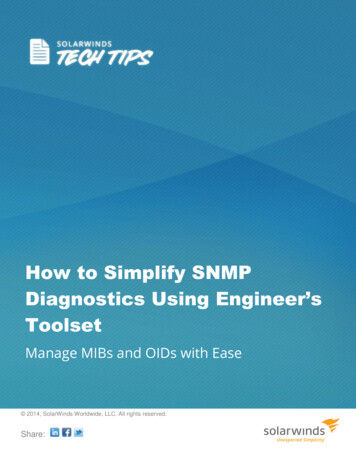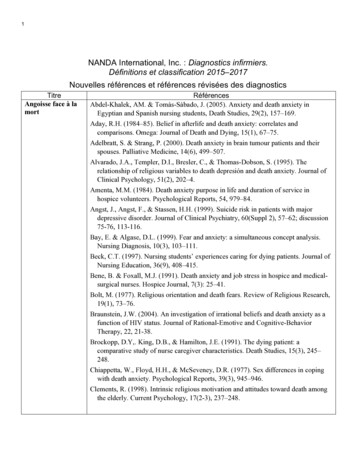
Transcription
1NANDA International, Inc. : Diagnostics infirmiers.Définitions et classification 2015–2017Nouvelles références et références révisées des diagnosticsTitreAngoisse face à lamortRéférencesAbdel-Khalek, AM. & Tomàs-Sàbado, J. (2005). Anxiety and death anxiety inEgyptian and Spanish nursing students, Death Studies, 29(2), 157–169.Aday, R.H. (1984–85). Belief in afterlife and death anxiety: correlates andcomparisons. Omega: Journal of Death and Dying, 15(1), 67–75.Adelbratt, S. & Strang, P. (2000). Death anxiety in brain tumour patients and theirspouses. Palliative Medicine, 14(6), 499–507.Alvarado, J.A., Templer, D.I., Bresler, C., & Thomas-Dobson, S. (1995). Therelationship of religious variables to death depresión and death anxiety. Journal ofClinical Psychology, 51(2), 202–4.Amenta, M.M. (1984). Death anxiety purpose in life and duration of service inhospice volunteers. Psychological Reports, 54, 979–84.Angst, J., Angst, F., & Stassen, H.H. (1999). Suicide risk in patients with majordepressive disorder. Journal of Clinical Psychiatry, 60(Suppl 2), 57–62; discussion75-76, 113-116.Bay, E. & Algase, D.L. (1999). Fear and anxiety: a simultaneous concept analysis.Nursing Diagnosis, 10(3), 103–111.Beck, C.T. (1997). Nursing students’ experiences caring for dying patients. Journal ofNursing Education, 36(9), 408–415.Bene, B. & Foxall, M.J. (1991). Death anxiety and job stress in hospice and medicalsurgical nurses. Hospice Journal, 7(3): 25–41.Bolt, M. (1977). Religious orientation and death fears. Review of Religious Research,19(1), 73–76.Braunstein, J.W. (2004). An investigation of irrational beliefs and death anxiety as afunction of HIV status. Journal of Rational-Emotive and Cognitive-BehaviorTherapy, 22, 21-38.Brockopp, D.Y,. King, D.B., & Hamilton, J.E. (1991). The dying patient: acomparative study of nurse caregiver characteristics. Death Studies, 15(3), 245–248.Chiappetta, W., Floyd, H.H., & McSeveney, D.R. (1977). Sex differences in copingwith death anxiety. Psychological Reports, 39(3), 945–946.Clements, R. (1998). Intrinsic religious motivation and attitudes toward death amongthe elderly. Current Psychology, 17(2-3), 237–248.
2Cully, J.A., La Voie, D., & Gfeller, J.D. (2001). Reminiscence, personality, andpsychological functioning in older adults. Gerontologist, 41(1), 89–95.Hunt, B. & Rosenthal, D.A. (2000). Rehabilitation counselors’ experiences with clientdeath anxiety. Journal of Rehabilitation, 66(4), 44–50.Kuuppelomaky, M. (2000). Cancer patients’, family members’ and professionalhelpers’ conceptions and beliefs concerning death. European Journal of OncologyNursing, 4(1), 39–47.Kastenbaum, R, (1992). The psychology of death. New York: The Guilford Press.Matalon, T.H. (2000). The relationship among children’s conceptualisation of death,parental communication about death, and parental death anxiety. DissertationAbstracts International Section A: Humanities & Social Sciences, 61, (2-A), 510511. Source: 0.Mok, E., Lee, W.M., & Wong, F.K. (2002). The issue of death and dying: employingproblem-based learning in nursing education. Nurse Education Today, 22(4), 319–329.Nelson, L.D. & Cantrell, C.H. (1980). Religiosity and death anxiety: A multidimensional Analysis. Review of religious Research, 21(2), 148–157.Rasmussen, C.A. & Brems, C. (1996). The relationship of death anxiety with agepsychosocial maturity. Journal of Psychology, 130(2), 141–144.Rasmussen, C.H. & Johnson, M.E. (1994). Spirituality and religiosity: Relativerelationships to death anxiety. Omega: Journal of Death and Dying, 29(4), 313–318.Robbins, R.A. (1992). Death competency: a study of hospice volunteers. DeathStudies, 16(6), 557–569.Rosenhein, E. & Muchnick, B. (1984–85). Death concerns in differential levels ofconsciousness as functions of defence strategy and religious belief. Omega: Journalof Death and Dying, 15(1), 15–24.Sanders, J.F., Poole, T.E., & Rivero, W.T. (1980). Death anxiety among the elderly.Psychological Reports, 46, 53–54.Sherman, D.W. (1996). Nurses’ willingness to care for AIDS patients and spirituality,social support, and death anxiety. Image: Journal of Nursing Scholarship, 28(3),205–213.Stoller, E.P. (1980–81). The impact of death-related fears on attitudes of nurses inhospital work setting. Omega: Journal of Death and Dying, 11, 85–96.Straub, S.H., & Roberts, J.M. (2001). Fear of death in widows: Effects of age atwidowhood and suddenness of death. Omega: Journal of Death and Dying, 43(1),25–41.Sulmasy, D.P. & McIlvane, J.M. (2002). Patients’ ratings of quality and satisfactionwith care at the end of life. Archive of Internal Medicine, 162(18), 2098–2104.
3Whitley, G.G. (1994). Expert validation and differentiation of the nursing diagnosisanxiety and fear. Nursing Diagnosis, 5(4), 143–150.Whitley, G.G. & Tousman, S.A. (1996). A multivariate approach for validation ofanxiety and fear. Nursing Diagnosis, 7(3), 116–124.Auto-négligenceAbrams, R.C., Lachs, M., McAvay, G., Keohane, D.J., & Bruce, M.L. (2002).Predictors of self-neglect in community-dwelling elders. American Journal ofPsychiatry, 159(10), 1724–1730.Adams, J. & Johnson, J. (1998). Nurses’ perceptions of gross self-neglect amongstolder people living in the community. Journal of Clinical Nursing, 7(6), 547–552.Al-Adwani, A. & Nabi, W. (2001). Coexisting Diogenes and Capgras syndromes.International Journal of Psychiatry in Clinical Practice, 5(1), 75–76.Barocka A., Seehuber D., & Schone, D. (2004.) Messy House Syndrome. MMWFortschritte der Medizin, 146(45), 36–39.Blondell, R.D. (1999). Alcohol abuse and self-neglect in the elderly. Journal of ElderAbuse and Neglect, 11(2), 55–75.Bozinovski, S.D. (2000). Older self-neglecters: Interpersonal problems and themaintenance of self-continuity. Journal of Elder Abuse & Neglect, 12(1), 37–56.Branch, L. (2002). The epidemiology of elder abuse and neglect. The Public Policyand Aging Report, 12(2), 19–22.Chang, B., Uman, G. & Hirsch, M. (1998). Predictive power of clinical indicators forself-care deficit. Nursing Diagnosis, 9(2), 71–82.Clark, A.N.G., Mankikar, G.D., & Gray, I. (1975). Diogenes syndrome: A clinicalstudy of gross neglect in old age. Lancet, 305(7903), 366–368.Daly, J.M. & Jogerst, G. (2001). Statute definitions of elder abuse. Journal of ElderAbuse and Neglect, 13(4), 39–57.Drummond, L.M., Turner, J., & Reid, S. (1997). Diogenes’ syndrome: A load of oldrubbish? Irish Journal of Psychological Medicine, 14(3), 99–102.Dyer, C.B., Pavlik, V.N., Murphy, K.P., & Hyman, D.J. (2000). The high prevalenceof depression and dementia in elder abuse or neglect. Journal of the AmericanGeriatrics Society, 48(2), 205–208.Esposito, D., Rouillon, F., & Limosin, F. (2003). Diogenes syndrome in a pair ofsiblings. Canadian Journal of Psychiatry, 48(8), 571–572.Finkel, S.I. (2003). Cognitive screening in the primary care setting: The role ofphysicians at the first point of entry. Geriatrics, (6), 43–44.Gee, A., Jones, J.S., & Brown, M.D. (1998). Self-neglect in the elderly: Emergencydepartment assessment and crisis intervention. Annals of Emergency Medicine,32(30, suppl, Part 2), S42.
4Gibbons S. (2007). Characteristics and behaviors of self-neglect in communitydwelling older adults. (Doctoral dissertation). Source: Dissertation AbstractsInternational, UMI No. 3246949.Gibbons, S., Lauder, W., & Ludwick, R. (2006). Self-neglect: A proposed newNANDA diagnosis. International Journal of Nursing Terminologies andClassification 17(1), 10–18.Greve, K.W., Curtis, K.L., Bianchini, K.J., & Collins, B.T. (2004). Personalitydisorder masquerading as dementia: a case of apparent Diogenes syndrome.International Journal of Geriatric Psychiatry, 19(7), 703–705.Gruman, C.A., Stern, A.S., & Caro, F.G. (1997). Self-neglect among the elderly: Adistinct phenomenon. Journal of Mental Health and Aging, 3(3), 309–323.Gunstone, S. (2003). Risk assessment and management of patients whom self-neglect:a grey area for mental health workers. Journal of Psychiatric and Mental HealthNursing, 10(3), 287–296.Halliday, G., Banerjee, S., Philpot, M., & Macdonald, A. (2000). Community study ofpeople who live in squalor. The Lancet, 355(9207), 882–886.Jackson, G.A. (1997). Diogenes syndrome: How should we manage it? Journal ofMental Health, 6(2), 113–116.Jurgens, A. (2000). Refuse hoarding syndrome. Psychiatrische Praxis, 27(1), 42–6.Lachs, M.S., Williams, C.S., O’Brien, S., & Pillemer, K.A. (2002). Adult protectiveservices use and nursing home placement. The Gerontologist, 42(6), 734–739.Lachs, M.S., Williams, C.S., O’Brien, S., Pillemer, K.A., & Charlson, M.E. (1998).The mortality of elder mistreatment. Journal of the American Medical Association,280(5), 428–32.Lauder, W. (2001). The utility of self-care theory as a theoretical basis for selfneglect. Journal of Advanced Nursing, 34(4), 345–351.Lauder, W. (1999a). A survey of self-neglect in patients living in the community.Journal of Clinical Nursing, 8(1), 95–102.Lauder, W. (1999b). Constructions of self-neglect: a multiple case study design.Nursing Inquiry, 6(1), 48–57.Lauder, W., Anderson, I., & Barclay, A. (2005). Guidelines for good practice in selfneglect. Journal of Psychiatric and Mental Health Nursing, 12(2), 192–198.Lauder, W., Anderson, I., & Barclay, A. (2002). Housing and self-neglect: Clients’and carers’ perspectives. Report to the Economic and Social Research Council.Award No. R000223387.Lauder, W., Scott, P.A., & Whyte, A. (2001). Nurses’ judgments of self-neglect: Afactorial survey. International Journal of Nursing Studies, 38(5), 601–608.
5Longres, J.F. (1995). Self-neglect among the elderly. Journal of Elder Abuse &Neglect, 7(1), 69–86.Macmillan, D. & Shaw, P. (1966). Senile breakdown in standards of personal andenvironmental cleanliness. British Medical Journal, 2(5521), 1032–1037.National Center on Elder Abuse. (1998). National Elder Abuse Incidence Study.Washington, DC: The Administration for Children and Families and theAdministration on Aging, US Department of Health and Human Services.O’Brien, J.G., Thibault, J.M., Turner, L.C., & Laird-Fick, H.S. (1999). Self-neglect:an overview. Journal of Elder Abuse & Neglect, 11(2), 1–19.Orem, D.E. (1995). Nursing: Concepts of practice (5 ed.). St. Louis, MO: MosbyYearbook, Inc.Orrell, M.W., Sahakin, B.J., & Bergmann, K. (1989). Self-neglect and frontal lobedysfunction. British Journal of Psychiatry, 155, 101–105.Pavlik, V.N., Hyman, D.J., Festa, N.A., & Dyer, C.B. (2001). Quantifying theproblem of abuse and neglect in adults – analysis of a statewide database. Journal ofthe American Geriatrics Society, 49(1), 45–48.Radebaugh, T.S., Hooper, F.J., & Gruenberg, E.M. (1987). The social breakdownsyndrome in the elderly population living in the community: The helping study.British Journal of Psychiatry 151, 341–346.Rathbone-McCuan, E. & Bricker-Jenkins, M. (1992). A general framework for elderself-neglect. In E. Rathbone-McCuan & D. R. Fabian (Eds.). Self-neglecting elders:A clinical dilemma. Westport, CT: Auburn House.Reifler, B. (1996). Diogenes syndrome: Of omelettes and souffles. Journal of theAmerican Geriatrics Society, 44(12), 1484–1485.Reyes-Ortiz, C.A. (2001). Diogenes syndrome: The self-neglect elderly.Comprehensive Therapy, 27(2), 117–121.Roby, J.L. & Sullivan, R. (2000). Adult protection service laws: a comparison of statestatutes from definition to case closure. Journal of Elder Abuse and Neglect,12(3/4), 17–51.Roe, P.F. (1987). Self-neglect or chosen lifestyle? [Letter]. British Journal of HospitalMedicine, 37(1), 83–84.Sengstock, M.C., Thibault, J.M., & Zaranek, R. (1999). Community dimensions ofelderly self-neglect. Journal of Elder Abuse & Neglect, 11(2), 77–93.Snowdon, J. (1987). Uncleanliness among persons seen by community health workers.Hospital & Community Psychiatry, 38(5), 491–494.Tierney, M.C., Charles, J., Naglie, G., Jaglal, S., Kiss, A., & Fisher, R.H. (2004). Riskfor harm in cognitively impaired seniors who live alone: A prospective study.Journal of the American Geriatrics Society, 52(9), 1576–1577.
6Ungvari, G.S. & Hantz, P.M. (1991). Social breakdown in the elderly, I. Case studiesand management. Comprehensive Psychiatry, 32(5), 440–444.Vostanis, P. & Dean, C. (1992). Self-neglect in adult life. British Journal ofPsychiatry, 161, 265–267. PMID: 1521114.Bien-être altéréCameron, B.L. (1993). The nature of comfort to hospitalized medical surgical patients.Journal of Advanced Nursing, 18(3), 424–436.Honkus, V. (2003). Sleep deprivation in critical care units. Critical Care NursingQuarterly, 26(3), 179-189.Jenny, J. & Logan, J. (1996). Caring and comfort Metaphors used by patients incritical care. Image: Journal of Nursing Scholarship, 28(4), 349–352.Kolcaba, K., Schirm, V. & Steiner, R. (2006). Effects of Hand Massage on Comfort ofNursing Home Residents. Geriatric Nursing, 27(2), 85-91.Kolcaba, K. (2003). Comfort theory and practice: A vision for holistic health care andresearch. New York: Springer Publishing Co.Kolcaba, K. & Fox, C. (1999). The effects of guided imagery on comfort of womenwith early-stage breast cancer going through radiation therapy. Oncology NursingForum, 26(1), 67-71.Kolcaba, K. (1992). The concept of comfort in an environmental framework. Journalof Gerotological Nursing, 18(6), 33-38.Minden P. (2005). The importance of words: Suggesting comfort rather than pain.Holistic nursing practice 19(6), 267-271.Schoener, C. (1996). The comfort and discomfort of infertility. JOGNN, 25(2), 167172.Taylor, B (1992). Relieving pain through ordinariness in nursing: a phenomenologicalaccount of a comforting nurse-patient encounter. Advances in NursingScience,15(1), 33-43.Wilson, L. (2002). An investigation of the relationships of perceived nurse caring,social support and emotion-focused coping to comfort in hospitalized medicalpatients. Dissertation Abstracts International, (UMI No. AA13043623).Walker, A. (2002). Safety and comfort work of nurses glimpsed through patientnarrati
NANDA diagnosis. International Journal of Nursing Terminologies and Classification 17(1), 10–18. Greve, K.W., Curtis, K.L., Bianchini, K.J., & Collins, B.T.

